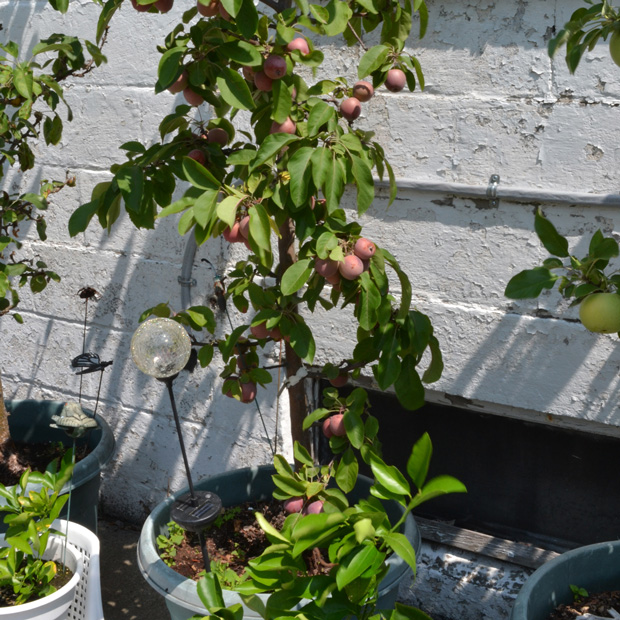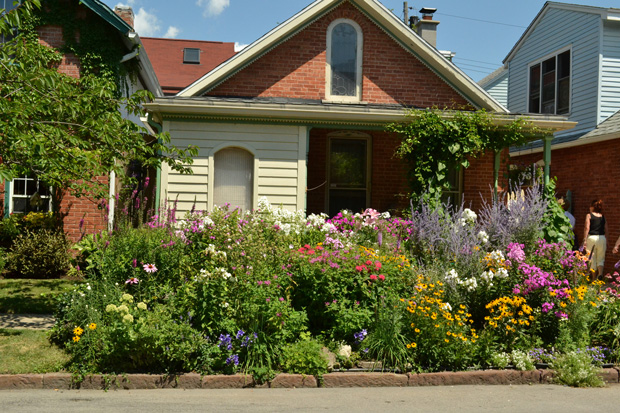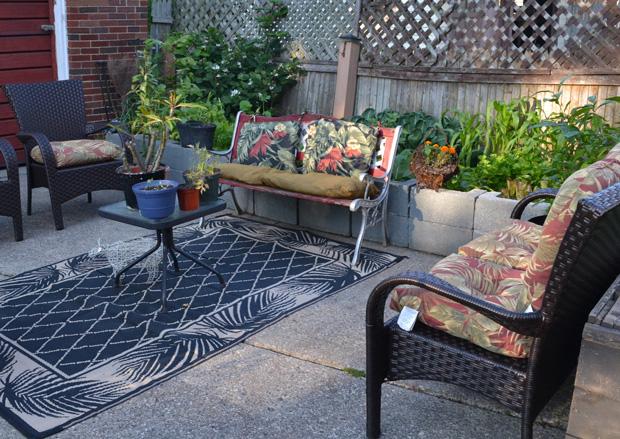Yes, You Have Room to Garden
Does your outdoor space consist of nothing more than a balcony or a back stoop?
Then you have room to garden.
And if you’ve got a teeny yard, you’re golden.
No excuses. This summer, grow something.
Container gardening is real gardening
Several years ago, a gardener on the Black Rock & Riverside Tour of Gardens told me, “You can put anything in containers and you can put containers anywhere.”
He had a real apple tree—with apples you can eat—growing in a pot on his driveway. He had a pear tree growing in a larger container—a garbage can.

Growing plants in a container counts as real gardening. This type of gardening even has a name: container gardening. Yes, you can be a real gardener even if you don’t have a garden bed.
Bonus: If you’re renting and have to move partway through the summer, you can take your garden with you.
While many full-size plants can be grown successfully in containers, there are varieties of trees, shrubs and other plants that have been developed to fit better in pots and small landscapes. That apple tree in Black Rock is a columnar apple, a type that grows straight up and stays shorter. “Raspberry Shortcake” is a variety of raspberry that doesn’t get lanky canes like other raspberry bushes and is shorter, fuller, and denser. “Patio Baby” is a smaller, compact version of eggplant. (Another nice feature of Patio Baby is that it doesn’t have thorns on its leaves like other eggplants.) “Rapunzel” is a cascading tomato plant that can be grown in a hanging basket.
While you can grow anything in pots, if you want to grow trees, shrubs, or perennials that come back year after year, there is one thing you should know: You have to take steps to help that potted plant make it through the winter. And that may take more space than you have.
A tree grown in a container has to be placed in a sheltered spot, such as an unheated garage, for the winter. If you don’t have a garage but you have some space, you can try placing straw bales around the pot.
What you’re doing is attempting to protect the roots of the plant from extremely cold winter temperatures as well as wild swings in temperature. When a tree is planted in the ground, the roots are protected from fluctuations in air temperature because the ground freezes and stays at 32 degrees Fahrenheit (more or less) all winter long. Even if the air temperature goes up to 50 degrees for a few days then down to 10 below for a few days, the soil around the roots stays at a fairly consistent temperature.
Plants in pots, however, can be damaged by fluctuations in air temperature or by very low temperatures.
If you don’t have the space required to overwinter a tree, you might want to stick with shrubs and perennials that can be grown in smaller containers. You might be able to safely insulate them by heaping lots of mulch on top of and around the pot, and even on a balcony, you might have enough room to do that.
Your other option is to choose annuals, either flowers or vegetables, that don’t have to be nursed through the winter.
What to use and how to plant
Pretty much anything that holds dirt can be used as a container. Use containers with holes in the bottom to allow for drainage.
Your container can be as simple as a five-gallon bucket (use a hammer and nail to punch holes in the bottom for drainage).
Even simpler is to use a bag of potting soil. Poke some holes in the bag for drainage. Flip it over and cut a hole in the top. Insert your tomato plant. Voila! You can enjoy fresh tomatoes on your balcony.
You can even use a straw bale as a container, though you should start the conditioning process two to four weeks before you want to plant into the straw bale. Water the bale until it is soaked through, then sprinkle the top with a high-nitrogen fertilizer. The idea is to get the bale to start to decompose. You want to leave enough time for this step because the bale will get hot as it decomposes, and you have to wait for the bale to cool. If the temperature in the bale is too high when you add your plants, it could damage the plants.
Once your straw bale is conditioned, dig down into the bale just enough to make room for the root ball of your plant, add a little soil and insert your plant. The roots of your plant will bind around the straw. Feed the plants with fertilizer once a week.
You can also use decorative containers to add color and beauty to your small space. Many gardeners like to use whimsical containers. I’ve seen flowers planted in watering cans, old shoes, old gutters, a picnic basket, dresser drawers, a metal hospital bed pan, an upside down glass lightshade and a wooden crate that used to hold pop bottles. Gardeners on the Ken-Ton Garden walk had different plants in many quirky containers, including a nine-foot cactus in a claw-foot bathtub. (They bring the cactus into the house for the winter, lopping off part of the plant to make it easier to move.)
Don’t forget about window boxes and hanging baskets.
Remember that you have to water small containers more often than large containers. During hot, dry weather, you might have to water small pots two or three times a day. But hey, caring for your plants is part of the fun of gardening!
Experts recommend using potting soil rather than soil from a garden bed for your pots. Garden soil is usually too dense to provide proper drainage and aeration. Plan on fertilizing your container, too.
Reclaim space: grassless yards, hellstrips, driveways
If you want a flower or vegetable garden, but all you have is a tiny urban front yard, get rid of the grass.
Grassless front yards are a distinctive feature of garden walks in Buffalo. Visitors love them. They’re charming and quaint.
But they’re practical, too. If you don’t have room for a garage or shed, every time you want to cut the grass, you have to drag the lawn mower up from the basement. Get rid of the grass and you can ditch the lawn mower, too.
People generally squeeze in as many flowers as they can, usually perennials with some annuals thrown in. There may be paths so they can get at the plants for weeding. Vegetable plants and herbs are often mixed in with the flowers, rather than being relegated to their own vegetable patch. Don’t forget about those smaller shrubs and other plants that work in pots. They will work in a small garden bed, too.

You can reclaim even more room by planting in the space between the sidewalk and street, dubbed the hellstrip. It’s where the plows deposit the heavy, salty snow from the street. Garbage cans get tossed there. Dogs do their business there.
But don’t be put off by its name; you can grow things in the hellstrip. A nice example of a garden that has plants growing during three seasons can be seen on the Parkside Garden Tour. Everything is hardy and durable, the gardener assured me, and if people trample the plants getting into and out of their cars, the plants will be fine.
That gardener has spring plants including squill, a plant that gets little blue flowers, as well as grape hyacinths and tulips. Summer flowers include Marguerite daisies, lavender, globe thistle, daylilies and rudbeckia. In late fall, she has Zauschneria or hummingbird vine, which gets an orange tubular flower that attracts hummingbirds.
If you have a driveway, reclaim some of that space by building a raised bed on top of the asphalt.
A gardener on the Samuel P. Capen Garden Walk made a simple raised bed by stacking cinder blocks (actually half blocks) that she got from Buffalo ReUse.
I checked with Cornell Cooperative Extension about whether it’s safe to use cinder blocks in a garden where you’re growing vegetables and other food plants. The concern cited in many warnings is specifically fly ash, the residue you get from burning coal. While that might have been used in older cinder blocks, it’s not commonly used anymore so it shouldn’t be a problem.
However, one thing you should take into consideration when using old bricks, old concrete blocks or other recycled material is where those materials came from. The materials may have been resting in soil that was contaminated with chemicals. If you’re going to use bricks for pathways, pressure washing the materials should be sufficient. If you’re using materials for a vegetable garden, you would want to be more cautious. If you’re unsure of the source of used materials, it’s recommended that you use new material.
If you can’t spread out, go up
A woman I met on Garden Walk Buffalo explained that if she had her way, she would keep expanding her gardens into the lawn. However, her husband noted that they liked to have parties, and, well, people needed somewhere to stand.
What she did was what many gardeners do when they can’t spread out: they go up. She attached a wire grid to the fence, then chose plants that would grow along that grid.
Another way to go vertical is to hang shelves on a fence and set containers on the shelves. Of course, you can also attach window boxes directly on a fence. Use a shepherd’s hook to hold hanging baskets.
Still another way to make the most of your space is to employ espalier techniques. You take a fruit tree or ornamental shrub and train the branches to grow flat against a wall, supported on a lattice. The plant becomes practically two-dimensional.
Get inspired on garden walks
When you go on garden walks, by all means admire the beauty of the landscapes, but then take a moment to shift gears and look again with a practical eye. Figure out what aspects you can copy in your own place. What flowers did they group in that container to make it look so pretty? Are those herbs growing in the window boxes on the balcony railing? If you have a question, ask it. Gardeners love to talk about their gardens and share ideas!
Notice that I am talking about garden walks—plural. People around here talk about the garden walk, referring to Garden Walk Buffalo, and that event deserves all the prestige it gets. There were 400 gardens on Garden Walk Buffalo last year, and it’s the largest garden tour in the country. It’s amazing.
But even more amazing is the fact that other neighborhoods and towns have followed suit and created their own garden walks. This year there will a total of 21 garden walks! See more here.
But wait, it gets even better: You can visit selected gardens during Open Gardens on Thursdays and Fridays in July. Buy the guide in various locations, listed on the Garden Walk Buffalo website.
Now go outside grow something this year. And next year consider sharing your small garden on the garden walk in your area.
Connie Oswald Stofko is the publisher of Buffalo-NiagaraGardening.com.

